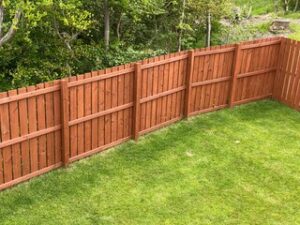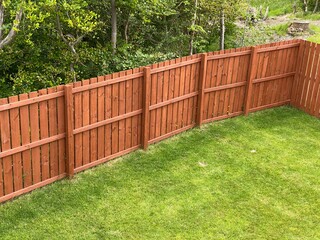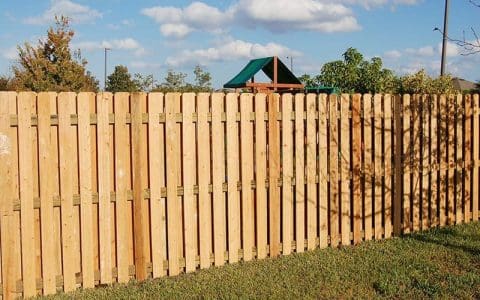Using paints, stains, and other treatments, wood fencing can be customized to fit the aesthetics of any home. However, a wood fence must be well-maintained to keep it durable and attractive.
Consider the local weather conditions, which may affect the lifespan of the wood. Pine and pressure-treated wood may require more frequent staining to protect it from rot and insects. Contact All American Gutters and Fences for professional help.
Pine fencing is a popular option for homeowners who want to add value to their home and increase privacy without breaking the bank. It is less expensive than other materials, including metal and vinyl fencing, and it is easy to clean and maintain. Pine is also relatively durable and resistant to rotting, splintering, and insects. Many homeowners choose to have their pine fences pressure treated to enhance its durability and lifespan.
The process of treating pine with preservatives does not damage the material, but some argue that the chemicals used in this treatment can leach into the soil, potentially causing harm to wildlife and other plants. It is also important to know that while treated pine is a good choice for your yard, it will not last as long as cedar or other higher-quality woods.
Another consideration when choosing a wood fence is your local weather. Certain wood types, such as redwood and cypress, are more durable than pine and are better suited for wet climates. However, pine is a more affordable choice for drier climates. This is why many cedar fences have pine posts and boards.
In addition to its affordability and durability, pine is also easy to work with and can be stained or painted. It is also less prone to warping, twisting, and shrinking than other woods, which makes it an ideal material for windy areas.
Another natural and environmentally friendly option is cedar, which is a good choice for wet climates. Cedar is naturally resistant to decay, insect infestation, and water damage and can withstand the elements without the need for chemical treatments. It also serves as a carbon sink, absorbing CO2 while it is growing and storing it even after being used as a fence. However, cedar is more expensive than other woods and can be difficult to source. It is also necessary to periodically inspect cedar fences for damage or signs of insect infestation, which can be a problem in humid climates.
Cypress
Wood fences offer a beautiful and timeless design that complements many different architectural styles. Each type of wood has its own unique grain patterns, colors, and textures that create a distinctive aesthetic. A professional fencing installer can guide you through the options to select a wood type that suits your taste and budget. Some types of wood are naturally resistant to insects, reducing the need for pest treatments. Other factors, like ease of installation and compatibility with specific fence designs, may also influence your decision.
Cypress wood, native to the Southern United States, has a natural resistance to insects and rot that enables it to last up to 30 years. The cypress tree contains a compound called cypretine, which gives the wood innate protection against pests. In addition to its durability, cypress is an eco-friendly option because it requires minimal chemical treatment. This reduces the amount of deforestation and supports sustainable forestry practices. Cypress fences are also ideal for windy areas, as they resist twisting and warping better than other wood species.
Cedar is another popular choice for wood fencing due to its natural oils that repel insects and help the wood resist rot and weathering. Cedar is also relatively lightweight and holds up well in wet climates, making it an excellent choice for homes located in humid areas. Its natural acids also make cedar less likely to warp than other softwoods, which makes it an ideal choice for fence posts. Cedar is a more expensive option than pine or cypress, but its longevity and beauty make it worth the investment.
Other common types of wood for fences include spruce and redwood, but these are not well-suited to wet climates. Spruce is prone to warping and rotting in damp climates, while redwood can be more susceptible to insect infestation. Cypress, on the other hand, is a durable wood that will not warp or rot in wet conditions and is an excellent choice for fences in humid environments.
Redwood
Redwood fencing adds a rich, natural beauty that other wood types simply can’t match. It also offers a high level of durability, resisting pests and rot better than most other types of wood fencing. And while it may cost more upfront than other types of fence materials, its longevity will save homeowners money over time on repair and maintenance costs.
The tannins in redwood act as a natural preservative, eliminating the need for chemical treatments that can negatively impact pollinators. This makes it a perfect choice for Bay Area homes that value their green spaces, as it also keeps termites and other unwanted insects at bay. Redwood also puts up a strong fight against rot, as its oils form a barrier against moisture that tends to wreak havoc on other woods.
When selecting a redwood fence contractor, it’s important to find one with years of experience in the field. This will ensure that they are familiar with the material and can build a fence that will stand the test of time. Additionally, look for a contractor with insurance. Uninsured contractors may offer low upfront prices, but if an accident occurs on your property while they’re working, you could be held liable.
As with other wood types, redwood fences come in a variety of styles. You can choose between pickets, board-on-board, panel, or lattice fencing. Lattice fencing offers privacy and a unique aesthetic, while panel and board fencing offer solid barriers. No matter which style you select, it’s essential to properly maintain your redwood fence to extend its lifespan and beauty.
Choosing the right wood for your fence is an important decision that can impact the overall quality of your home’s landscaping and its value. To make the best decision, consider local weather conditions, maintenance requirements, and environmental impacts. With careful consideration, you’ll be able to select the ideal wood fencing for your Bay Area home.
If you have questions about what type of wood would work best for your home’s landscaping, contact us today to set up a consultation. We will help you choose the best fencing for your budget, needs, and aesthetics.
Cedar
Cedar is a classic wood fence option that can be used for many different purposes, including adding privacy to a home or keeping pets contained. Cedar fences are also known for their beauty and durability. Cedar lasts longer and is more resistant to rot and decay than other types of wood fencing, and it can be stained or painted to create any desired look.
There are a few different types of cedar, but one that’s particularly popular for fences is Western red cedar. This is a beautiful and durable wood that’s known for its strength and aesthetic. It also has natural oils that protect it from rotting and fungus, making it a great choice for fencing. Cedar is also lightweight and highly stable. It machines well and can be cut easily, so it’s a good option for any type of fencing style. Cedar’s natural oils also make it unattractive to insects, which helps keep your fence safe from infestations.
Like all types of wood, cedar needs some care to ensure it lasts a long time and keeps looking good. You’ll want to regularly stain or seal your cedar fence to prevent weathering and UV damage. This will also help prevent the wood from fading or graying over time. It’s best to use a high-quality stain, such as PENOFIN, which is available at our lumberyards.
Another advantage of using cedar for your fence is that it’s less toxic than other types of wood. This makes it a better choice for Southern Colorado homeowners who want to minimize the impact on their environment and avoid harmful chemicals. However, you should still take precautions when cutting and working with the wood. Always work in a well-ventilated area and wear masks and eye protection.
Cedar is an environmentally friendly choice for your fencing because it’s a renewable resource. It also requires less energy to process into building materials than other types of wood and synthetic products. Plus, with careful management practices in logging and harvesting, forests can be replenished within a short period. This makes it a better choice for the environment than other types of fencing materials, which often require dangerous chemical processing.


